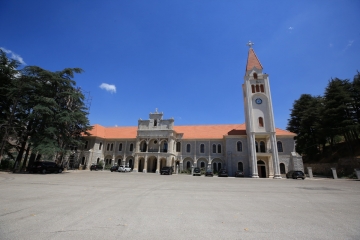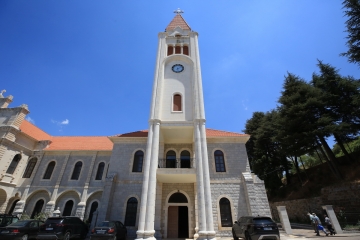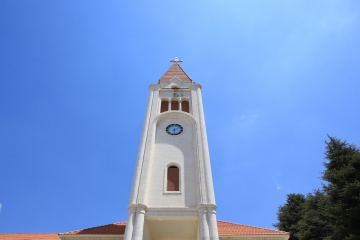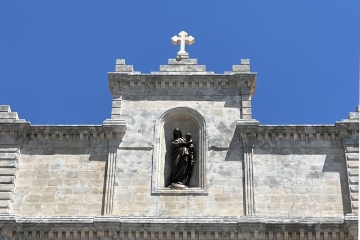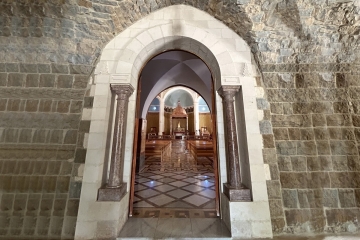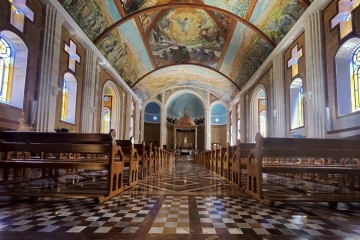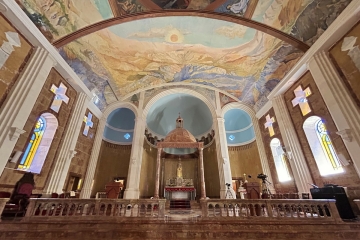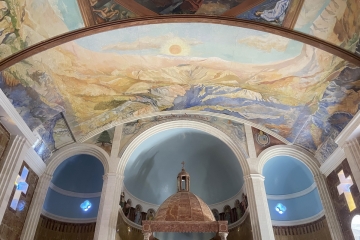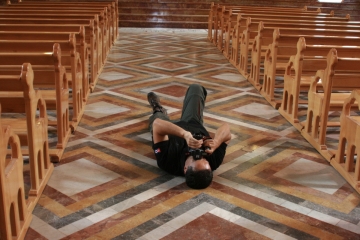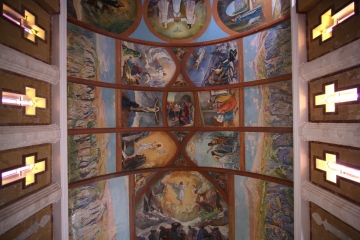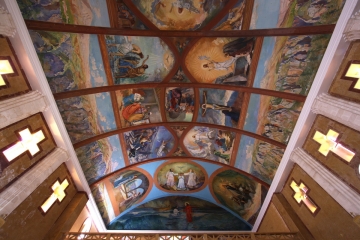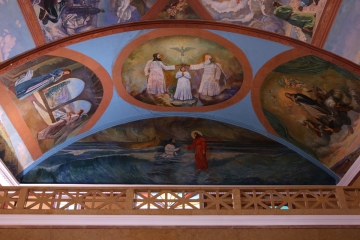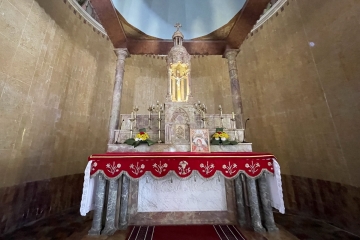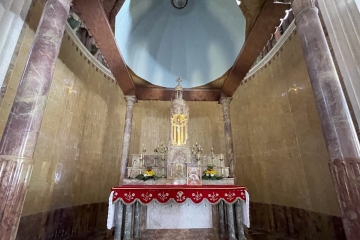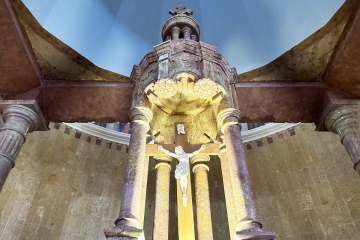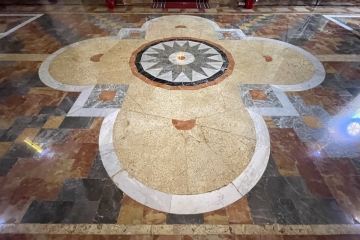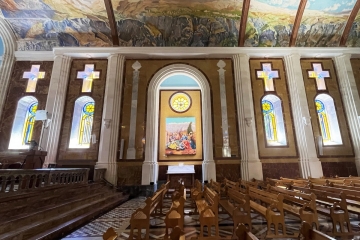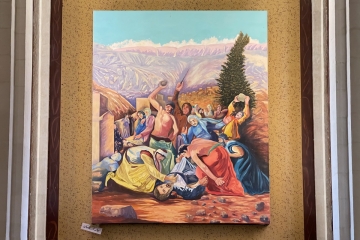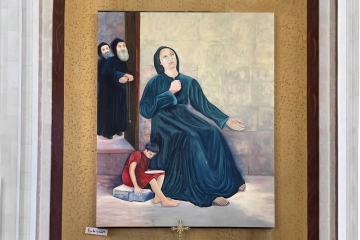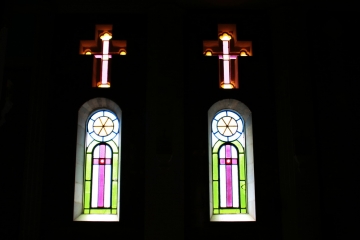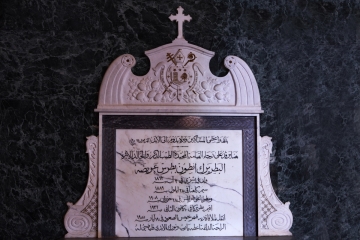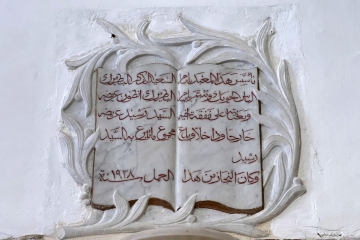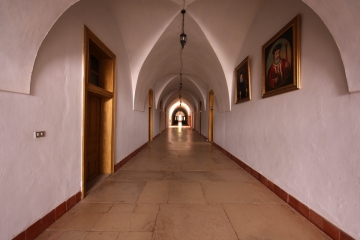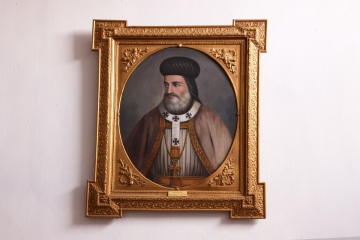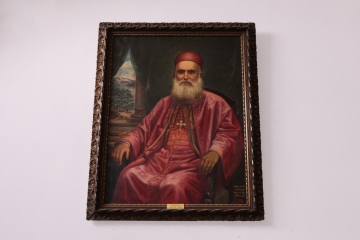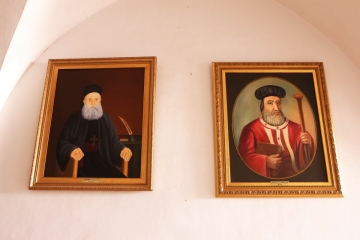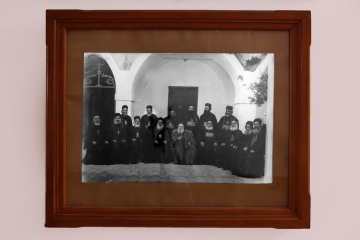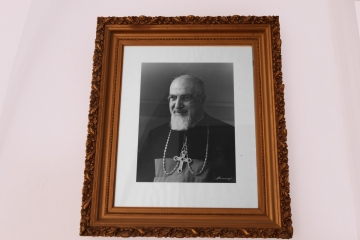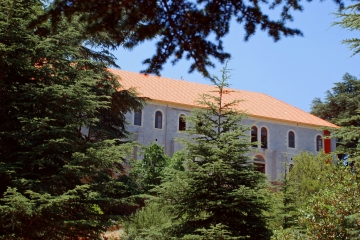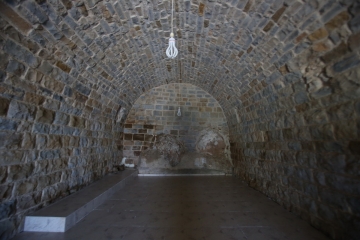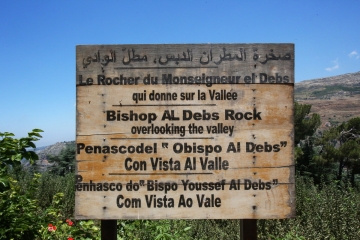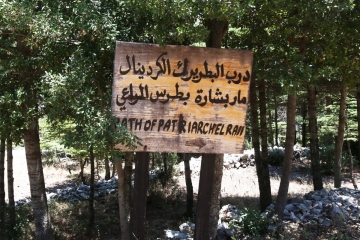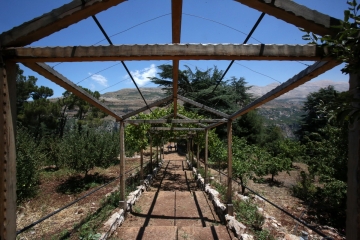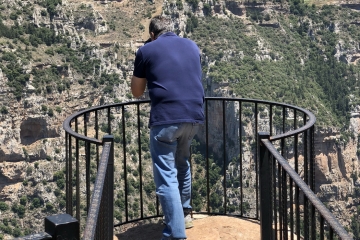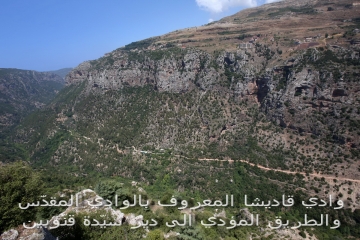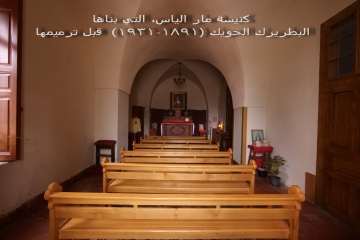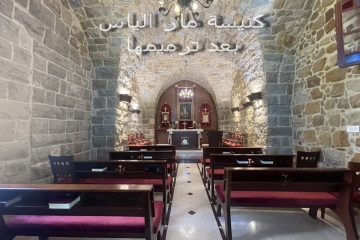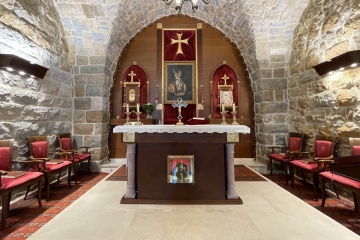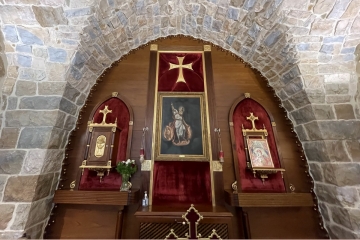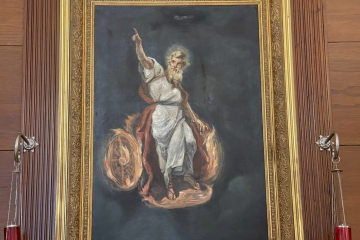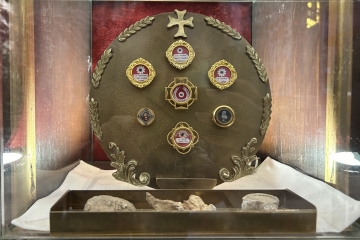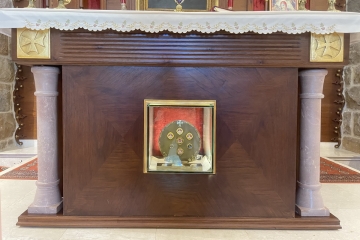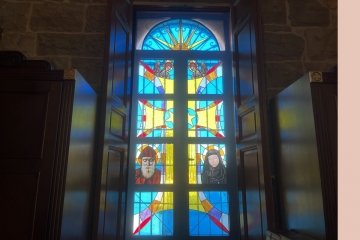دير السيّدة - الديمان
تاريخياً اشتُهِرت الديمان بِحيّ كفرصارون الذي هَدَمَه المَماليك في العام 1283 أثناء حَملتهم على الجِبّة. و"الديمان" تعني الشبه والكمال، وهي تَحتَوي على مغارة الجَماجم، ونبع الفرّاعة في جرودها.
وقبل بكركي والديمان لم يَكُن هناك مَقرٌّ بطريركيّ شتويّ وآخر صيفيّ، بل كان المقرُّ واحداً، وغالباً في الأنحاء الجبلية حيث الإصطياف مؤمَّن تلقائياً، أمّا في الشتاء فكان إتقاء العدوان والإضطِهاد في الأماكن النائية أهَمّ من إتقاء البرد والمطر، وهذا دون أن يَمنَع من وجود مَقرّات بطريركية ساحلية في بَعض الفَتَرات، كدير مار جرجس علما في بلدة ساحل علما القائمة على كَتف جونية، او الأديار النائية في الأماكن الوسطى التي تَصلُح مَشتىً وَمَصيفاً على السواء، كبلدة غوسطا التي تَضُمّ دير مار شلّيطا مقبس ودير مار يوسف الحصن ودير سيّدة نِسبيه، أو تلك الوِهدَة ما بين درعون وعين الريحانة التي تَحتَضِن دير مار يوحنّا حراش...
ولكنَّ المقرَّ المزدوج بدأ مع البطريرك يوسف حبيش (1823-1845)، الذي بَنى مقرَّاً مُتواضعاً له في مَنطقة الديمان، وكان يُقيم فيه أحياناً، وأحياناً في دير بكركي الذي قام بإصلاحه، كما في دير مار جِرجَس علما الذي ألمحنا اليه، والذي هو وقف عائلته آل حبيش.. وقائم في مَسقط رأسه ساحل علما.
ولكن إذا كان البطريرك حبيش (1823-1845) هو أول مَن انتقل إلى ناحية الديمان، فإن البطريرك أنطون عريضة (1932-1955)، إبن بشرّي، هو الذي قام بتَوسيع وتَرميم الصَرح الحاليّ وبناء كنيسته التي تَولّى الفنّان صليبا الدويهي رَسم أيقوناتها وجِدرانياتها الداخلية، وذلك بعد ان كان قد بدأ ببنائه البطريرك إلياس الحويّك (1899-1931). وقد أراد البطريرك أنطون عريضة (1932-1955) من بناء هذه الكنيسة أن تَحِلّ مَحلّ الكنيسة القديمة التي هي على اسم مار إلياس.. كونها كانت صغيرة ومُتواضعة لا تُناسب مَقرّاً بطريركياً، كما أوعز بتأسيس "حديقة البطاركة" إلى جانب الصرح.. مُشرفةً على وادي قنّوبين.
وقد استعان من أجل التوسعة والترميم بِمُساعَدَة مالية من شَقيقه المُغترب رشيد عريضة، وتؤرخ هذه الهِبة كتابة على البلاط الأرضي، قٌبالة المَذبح، جاء فيها :
" تبرَّع بِنِفِقَة هذه الكنيسة السيّد رشيد عريضة 1938".
وهناك أيضاً لوحة رخامية مُثبَتة على جِدار الكنيسة نَصَّت على ما يلي:
"تأسَّس هذا المَعبَد بأيام السعيد الذكر البطريرك إلياس الحويك، وتَرَمَّمَ بأيام البطريرك أنطون عريضة وبِعنايته على نَفَقَة أخيه السيّد رشيد عريضة خارجاً وداخلاً، وبَلَغَ مَجموع ما تبرَّع به السيّد (فراغ، لم يُذكر المبلغ)، وكان النِجاز من هذا العمل سنة 1938".
وعِبارة "تأسَّسَ" تُشير إلى كَون البطريرك إلياس الحويك (1899-1931) هو مَن بدأ ببناء الدير الحاليّ. وكان المُعلِّم المِعماري سِمعان يعقوب الحكَيّم أحد الذين ساهموا في هذا العمل، وهو الذي خَلّد ذِكرهُ الفنّان داوود القرم بِلَوحة زيتية من ريشته.. كما وَرَد في كتاب نادين محاسب عن داوود القرم.
وكان لِبناء دير الديمان مُقدَّمات، إذ عندما أصبحت المَنطقة الشمالية أكثر أماناً اتجهت أفكار البطاركة إلى الانتقال من دير قنّوبين، الذي كان شِبه مَلجأ لَهُم في أيام الشِدَّة، إلى مَقَرّ أحدث وأكثر توفيراً لشروط الإقامة. ولكن بانتظار جهوز الدير الجديد سَكن البطريرك حبيش أولاً بيتاً لأحد الشُركاء، أي العاملين في أرزاق البطريركية، قائماً غربيَّ البلدة ويُشرف على الوادي. ثم بَنى البطريرك يوحنا الحاج (1890-1898) الكرسيَّ القَديم في وسط البلدة سنة 1890، وبنى إلى جانبه كنيسة مار يوحنّا مارون وهي اليوم كنيسة الرعائية، وما يزال هذا الكرسيُّ القديم ماثلاً للعيان.
كنيسة هذا الصرح مَبنيَّة على الطِراز اللبنانيّ العَريق، وتُزيّنها، كما ذَكرنا، جِداريات الفنان اللبناني العالميّ صليبا الدويهي، وهي من أجمَل ما يُمكن ان تراه العين، وعَلَت مَذبَحها عبارة: "مجد لبنان أُعطي له" باللغة السريانية.
وُلد هذا الفنان في اهدن عام 1909، ومنذ صِغَره كان يَنسُخ الرسوم عن كتبه المدرسية.. دلالةً على مَوهَبتِه الباكرة في اتقان فن الرسم. وقد تَطَورَت ريشته بِسُرعة لافتة، بِحَيث حَمَّله البطريرك الحويك (1998-1931) رسالة توصية إلى الفنّان حبيب سرور الذي اختبره وأُعجِبَ به، فبدأ يُعلَّمَه الرَسمَ في العام 1928. وبعد أربع سنواتٍ من ذلك، حَصَل على مِنحَة دِراسية في أحد مَعاهِد فرنسا الفنّية، وبعدها انتقل إلى إيطاليا إتماماً لتَحصيله في ميدان الرَسم.
أثناء تَشييد هذه الكنيسة، استُدْعِيَ صليبا من قِبَل البطريرك أنطون عريضة (1932-1955) لتَزيينها برُسومِه الفنّية، فَنَفّذ ذلك خِلال أربع سنوات، وكان عَمَلَه مزيجاً من الإنطباعية والكلاسيكية. في تلك المَرحَلة كان الدويهي مُشْبَعاً بأعمال كبار الفنانين الكلاسيكيين، مِثل مايكل آنج ودافنتشي، لذلك جاءت جميع رسومه وِفقَ الأصول الكلاسيكية المَعروفة مع فارق تجديدي وحيد هو أنه إستعمل نماذج من الوجوه القرويّة اللبنانية، ومن الناس العاديين، عِوَضاً عن النَماذج الكلاسيكية الايطالية، ومن هنا أتَت ميزة رسوم هذه الكنيسة إن أشخاصها هم قريون لبنانيون شرقيون (مثل لوحة الرُعاة، ولوحة رَجم شَهيد بَسري، والخَلفية في لوحة العماد، والعذراء في لوحة البِشارة، ولوحة القديسة مارينا).
ولِطَرافَة الخَبَر، لا بُدّ من ذِكر أن عَمل الفنان الدويهي في الكنيسة لم يخلُ من مَتاعب، لأنه لم يَكن حُرّاً في عَملِه حَسبَ الأصول الفنيّة، بل كان البطريرك يَفرِض عليه ما يراه خارجاً عن هذه الأصول. وكان الرَسّام يلجأ أحياناً إلى الحيلة آملاً أن لا ينتبه البطريرك لذلك، فكان إمّا أن يَكتَشِف البطريرك حِيلته وإمّا أن يَكتَشَفها أحد الكهنة ويوشي بها للبطريرك.
وبعد أربع سنوات من الرُكوب في أعلى السِقالة وإنجاز العَمَل على ما يَهواه البطريرك، آملاً بأن يُجزِل له غبطته المُكافأة، إذا بهَذِه المُكافأة، من جانب البطريرك، كانت ذات وَجهَين: مَعنويّ يَقوم على إبلاغ زائري الكنيسة بأن روائعها هي بريشة صليبا الدويهي الذي أجهد نفسه في إنجازها مُدّة أربع سنوات، ومادّيّ يقوم على تَقديم مَطَبخ الدير الطَعام والشَراب للفنّان طِوال هذه المُدة، مِمّا جَعَلَه وهو يَغادر الصَرح يقول: "مرَّتين خَرَجتُ إلى الدنيا عُرياناً: مَرة من بَطن امّي، ومرَّة من كنيسة سيّدة الديمان".
تعاقب على الكرسيّ البطريركيّ الصيفي في الديمان لتاريخه عشرة بطاركة هم:
يوسف حبيش من ساحل علما (1823-1845)
يوسف راجي الخازن من عجلتون (1845-1854)
بولس مَسعد من عَشقوت (1954-1890)
يوحنا الحاج من دلبتا (1890-1898)
إلياس الحويّك من حِلتا (1899-1931)
أنطون عريضه من بشرّي (1932-1955)
بولس المعوشي من جِزّين (1955-1975)
أنطونيوس خريش من عين ابل (1975-1986)
نصرالله صفير من ريفون (1986-2011)
بشارة الراعي من حملايا (2011، انتُخب بطريركاً في 15/3/2011).
وهؤلاء البَطارِكَة هم أنفُسِهم الذين سَكَنوا شِتاءً في المَقرّ البطريركيّ الشتوي في بكركي.
البطريرك أنطون الثاني عريضة (1932-1955)
آثرنا ان نَذكُر هذا البطريرك في سِياق حديثنا عن دير الديمان كَونَه من بَلدة بشرّي جارة الديمان، ولأنه هو الذي وسَّع مَبنى هذا الدير وبنى كَنيسته وحَديقته وعند وفاته دُفن فيه.
انتُخِب هذا البطريرك في 17 كانون الثاني عام 1932 الذي يقع فيه عيد شفيعه مار مطانيوس، وأرسل له البابا بيوس الحادي عشر (1922-1939) دِرع التثبيت في 13 آذار من العام نفسه.
اسمه الأصلي سليم عبد الأحد عريضة، من بلدة بشرّي، تَخَرَّج من مَعهد سان سولبيس اللاهوتي في باريس.. بعد دِراسَته الكهنوتية في مدرسة مار يوسف الإكليريكية في غزير بدءاً من العام 1879.
وقد مرَّ مَعنا ما فعله في أثناء بطريركيته لكُرسيّ الديمان وكنيسته، ونَذكُر هنا أن من انجازاته أيضاً إنشاؤه مقرّاً للطائفة المارونية في مدينة مَرسيليا الفرنسية لخِدمة موارنة هذه المدينة.
على الصعيد الدينيّ، قسَّم البطريرك عريضة أعمال الكرسيّ البطريركيّ إلى دوائر، لكلّ ٍ منها شأن خاص يُعنى به ولا يتعدّاه، كما أنه أوعز بإجراء إحصاءٍ عامّ لأبناء الطائفة المارونية.
وفي عَهدِه تأسست "الرابطة المارونية"، وهي هيئة مَدنية تُساعِد في إدارة شؤون الكنيسة، كما صَدَر قانون الحَقّ الكَنسي للكنائس الكاثوليكية الشرقية، ويُقصد به ما يُسمّى بالفرنسية Droit canonique.
على الصعيد السِياسي رعى ما دُعي بـ "الميثاق الوطني" على أثر نَيل لبنان إستقلاله، وكان نوعاً من حلّ ٍ توفيقيّ بين نزعتَين سياسيتين كانتا تتقاسمان البلاد: النَزعَة العروبية، والنَزعَة اللبنانية التي لا ترى في لبنان جزءاً من العالم العربي لا بَل هو أقرب، دينياً وثقافياً، إلى الغرب، فجاء هذا الميثاق يجعل لبنان حيادياً عن الشرق والغرب على السواء، فلا يَدخل في وحدةٍ مع العرب، ولا يكون، من جهةٍ اخرى، للإستعمار مقرّاً وله ممرّاً إلى الدول العربية.
ولكن، في زَمَن الانتداب الفرنسيّ على لبنان، اختلف البطريرك عريضة مع المُفوَض السامي الفرنسي دو مارتيل، فأقام حواراً مع حزب الكتلة الوطنية في سوريا الذي كان مُناهضاً لهذا الانتداب على بَلاده، مِمّا جعل أركان هذا الحِزب ينادون باسمه من على منابر جَوامِع دِمشق هاتفين: "لا إله إلا الله، والبطريرك عريضة حَبيب الله".
وفي أيام الحرب العالمية الأولى، إذ فَتَك الجوع باللبنانيين وباتوا يموتون على الطُرقات، اشتُهر عن هذا البطريرك، إذ كان مطراناً على طرابلس، إنه رَهَن صَليبه وخاتِمَه الذهبيَّين لإطعام الجياع بثمنهما. وقد أشاد البطريرك الحاليّ مار بشارة بطرس الراعي بعمل البطريرك عريضة هذا في عِظة تولّيه السدَّة البطريركية، مُضيفاً إنه عَمِل ايضاً على استكمال لبنان إستقلاله عام 1943.
وفي الرابع عشر من حزيران عام 1948، مع تقدُّم البطريرك في العمر، عيَّن الكرسيّ الرسوليّ لجنةً مؤلفة من أربعة مَطارِنَة لتسيير الشؤون الإدارية في البطريركية، وهُم بولس المعوشي، الذي خَلَفه بعد وفاته، وعبدالله الخوري، وبطرس ديب وأغناطيوس زيادة، فاستمرَّت هذه اللجنة في عَمَلِها مُدة سَبع سنوات إلى أن توفي البطريرك عن عمر 91 عاماً في دير بكركي في 19 ايار 1955، فدُفن في كنيسة كرسيّ الديمان التي شَيدَّها، ويوجد في كنيسة هذا الدير لوحة تؤرّخ وفاته:
"بَدَّدَ وأعطَى المَساكينَ، فَبِرُّه يَدوم إلى الأبد (المزمور 9:111).
هنا يرقُد على رجاء القيامة المَجيدة الطيّبُ الذِكر والخالد الأثر
البطريرك أنطون بطرس عريضه
وُلد في بشرّي في 2 آب 1863
سيم كاهناً في 28 ايلول سنة 1889
ومطراناً على طرابلس في 28 حزيران 1908
أقيم بطريركاً في 10 كانون الثاني 1932
انتقل لمُلاقاة ربه ظهر خميس الصعود في 19 ايار1955
الراحة الدائمة اعطه يا رب ونورك الابدي فليضيء له".
وقد كتب في وصيَّته ان تُوزَّع أمواله التي ورثها عن عائلته على المَشاريع الخَيرية وإعالة الكَهنة المُسنّين، ويُذكر ان آخر كلماته كانت: "فليحفظ الله لبنان".
The Monastery of Our Lady of Diman
Historically, Al-Diman was famous for the Kfar Saroun neighborhood, which was demolished by the Mamluks in the year 1283 during their campaign on the Jubbah. “Al-Diman” means likeness and perfection, and it contains the cave of skulls, and the fountain of al-Farraa in its arid region. Before Bkerke and Diman, winter and summer patriarchal headquarters were one and the same, and often located in certain mountainous regions where the weather was clement in all seasons.
During the winter, remote locations were more important to avoid aggression and persecution than to avoid cold and heavy rain, but this did not prevent the existence of patriarchal headquarters in some coastal areas, such as the monastery of Saint George Alma in the town of Sahel Alma, looking over Jounieh, or remote monasteries in central places that are suitable for both winter and summer, such as the town of Ghosta, which hosts the monastery of Mar Chalita Muqbes, the monastery of Saint Joseph Al-Hosn and the monastery of Our Lady of Nesbih, or those located in the ravine between Daroun and Ain al-Rihana, such as the monastery of Saint John Harrach.
But the double headquarters began with Patriarch Youssef Hobeish (1823-1845), who sometimes stayed in a modest residence that he built for himself in the Diman area. He divided his time between this residence and the Bkerke Monastery which he had renovated, as well as the aforementioned monastery of St. George Alma, which belonged to the Hobeish family and which was located in his hometown of Sahel Alma.
But if Patriarch Hobeish (1823-1845) was the first to move to the Diman district, Patriarch Antoun Arida (1932-1955), hailing from Becharreh, was the one who expanded and restored the current edifice and built the church, of which the icons and interior murals were painted by the artist Saliba Douaihy, after its construction started during the time of Patriarch Elias Howayek (1899-1931). Patriarch Anton Arida (1932-1955) wanted this church to replace the old church that was named after Mar Elias, as it was small and modest and not suitable for a patriarchal residence. He also commissioned the "Patriarchs' Garden" next to the edifice, a garden that overlooks the Qannoubine Valley.
For the expansion and restoration, he sought financial assistance from his expatriate brother Rashid Arida, and this donation is mentioned in writing on a ground tile, opposite the altar: “Mr. Rashid Arida’s donation to this church 1938. There is also a marble plaque embedded in the church wall, which states the following: “This temple was established in the days of the honored Patriarch Elias Howayek, and it was restored inside and out under the supervision of Patriarch Antoun Arida at the expense of his brother, Mr. Rashid Arida, who donated a total amount of (Void, not mentioned).
The work was completed in 1938.” The phrase “founded” indicates that Patriarch Elias Howayek (1899-1931) was the one who initiated the construction of the current monastery. The architect Semaan Yaqoub Al-Hakim was one of those who contributed to this work, and he was immortalized by the artist Daoud al-Qorm in an oil painting, as is mentioned by Nadine Mohasseb in her book about Daoud al-Qorm.
The construction of the Diman headquarters happened gradually. When the northern region became safer, the patriarchs started considering moving from the Monastery of Qannoubine, which was a semi-refuge for them in times of hardship, to a newer and more appropriate residence. But while waiting for the new monastery to be ready, Patriarch Hobeish first dwelt in the house of one of the partners, that is, the workers on the patriarchal grounds, which stood to the west of the town and overlooked the valley. Patriarch Youhanna Al-Hajj (1890-1898) then built the old headquarters in the center of the town in 1890, and next to it he built St. John Maron Church, which is today the parish church; this old headquarters is still visible to this day.
The church of this edifice is built in the ancient Lebanese style, and it is adorned, as we mentioned, by the murals of the international Lebanese artist Saliba Douaihy, which are some of the most beautiful paintings in existence. Over the altar can be read the phrase: "The glory of Lebanon was given to him" in the Syriac language.
Saliba Doueihy was born in Ehden in 1909, and since childhood demonstrated a remarkable ability at drawing when he copied the drawings of his schoolbooks. His talent developed at a remarkable speed, and Patriarch Howayek (1998-1931) wrote a letter of recommendation to the artist Habib Sorour, who tested him and, admiring his talent, took him under his wing in 1928. Four years later, he received a scholarship to one of France's technical institutes, and, afterward, moved to Italy to complete his studies in the field of painting. During the construction of this church, Doueihy was summoned by Patriarch Antoun Arida (1932-1955) to adorn it with his paintings, which he did over the course of four years, and his work was a mixture of impressionism and classicism. At that stage, Doueihy was imbued with the works of great classical artists such as Michelangelo and Da Vinci, so all his drawings abided by the well-known classical principles, with the only innovative distinction being that his models were ordinary rural Lebanese people, instead of the classic Italian models. These features can be noticed in the paintings in the church (such as the painting of the shepherds, the painting of the stoning of a martyr in Bisri, the background in the painting of Baptism, the Virgin in the painting of the Annunciation, and the painting of Saint Marina). One should mention that the work of the artist Doueihy in the church was not without troubles, because he was not free to work according to artistic principles, but rather had to abide by the principles imposed by the patriarch. The painter sometimes resorted to trickery, hoping that the patriarch would not notice it, but it would always end up being discovered either by the patriarch or by one of the priests who would tell on him. After four years of working on scaffolds and following the patriarch’s instructions, hoping to be rewarded by His Beatitude, Doueihy was disappointed with his two-faced reward: moral, based on informing church visitors that its masterpieces were the result of the labor of Saliba Doueihy over four years, and material, which ended up being the meals provided to him by the church over four years. That made him say, as he left the edifice: “Twice I went out into the world naked: once when I exited my mother’s womb, and once when I exited the Church of Our Lady of Diman.” The patriarchs who succeeded each other in Diman:
Until today, 10 patriarchs have taken up residence in Diman:
Youssef Hobeish from Sahel Alma (1823-1845)
Youssef Raji Al-Khazen from Ajaltoun (1845-1854)
Boulos Massad from Achkout (1954-1890)
Youssef El-Hajj from Dlebta (1890-1898)
Elias Howayek from Halta (1899-1931)
Antoun Arida from Bcharre (1932-1955)
Boulos Meouchi from Jezzine (1955-1975)
Antonios Khraish from Ain Abel (1975-1986)
Nasrallah Sfeir from Rayfoun (1986-2011)
Bechara Al-Ra'i from Hemlaya (Elected on March 15, 2011-today).
These patriarchs also resided in the winter headquarters of Bkerke.
Patriarch Antoun Arida (1932-1955) We mention this patriarch in the context of our discussion of the Diman monastery, as he was from the neighboring town of Becharreh, and because he was the one who expanded the building of this monastery and built its church and garden, and upon his death was buried there.
This patriarch was elected on January 17, 1932, which falls on the day of the feast of his patron saint, Saint Antonios, and Pope Pius XI (1922-1939) sent him his confirmation shield on March 13th of the same year.
His original name is Salim Abdel Ahad Arida, from the town of Becharreh. He graduated from Saint-Sulpice Theological Seminary in Paris after his priestly studies at the Seminary of St. Joseph, in Ghazir, in 1879. On top of his services to the patriarchal headquarters of Diman and its church, he also established a headquarters for the Maronite community in the French city of Marseille to serve the Maronites of this city, and that is one of his most noteworthy achievements as well. On the religious level, the Patriarch divided tasks of the Patriarchal See into departments, each of which was concerned with specific duties.
He also requested a general census of the Maronite community. During his reign, the "Maronite League" was established, a civil body that helps manage the affairs of the Church, and a law on ecclesiastical rights was issued for the Eastern Catholic Churches, and it is known today as the Canonical Law. On the political level, he sponsored what is called the “National Pact” after Lebanon gained its independence, and it was a compromise between two political currents dividing the country: The Arab movement, and the Lebanese movement, which does not see Lebanon as part of the Arab world, but considers it closer, religiously and culturally, to the West. So this pact made Lebanon a neutral entity, so that it would not enter into unity with the Arabs, nor would it be, on the other hand, a base for colonialism and a passage to the Arab countries.
However, at the time of the French mandate over Lebanon, Patriarch Arida entered into a disagreement with the French High Commissioner De Martel, and he established a dialogue with the National Bloc Party in Syria, which was against this mandate over his country; this made the leaders of this party call out his name from the pulpits of Damascus mosques, shouting: “There is no god but God, and Patriarch Arida is God’s beloved.” During World War I, when famine was raging and the Lebanese dying of hunger in the streets, this patriarch, who was the bishop of Tripoli, famously pawned his cross and his golden ring to feed the hungry. The current Patriarch, Mar Bechara Boutros Al-Rahi, praised the work of Patriarch Arida in his sermon during his assumption of the patriarchal office, adding that he his work also contributed to Lebanon's independence in 1943.
This patriarch authored many literary books in the Arabic language, which were mentioned by Father Louis Sheikho in his book “The History of Arab Literature.” On June 14th, 1948, with the Patriarch advancing in age, the Holy See appointed a committee of four archbishops to run the administrative affairs of the Patriarchate, namely Boulos Al-Maouchi, who succeeded him after his death, Abdullah Al-Khoury, Boutros Deeb and Ignatius Ziadeh.
This committee continued its work for seven years, until the patriarch died at the age of 91 in the monastery of Bkerke on May 19, 1955. He was buried in the Church of Diman which he had built, and in the church of this monastery, there is a plaque that commemorates his death. “He sent redemption unto his people: he hath commanded his covenant for ever: holy and reverend is his name.”- Psalm 9:111 Here lies in the hope of glorious resurrection, the gratefully and eternally remembered Patriarch Antoun Boutros Arida Born in Becharreh on August 2, 1863
Ordained a priest on September 28, 1889
Appointed Archbishop of Tripoli on June 28, 1908
Appointed Patriarch on January 10, 1932
He passed away at noon on Thursday of the Ascension, on May 19, 1955. May his soul rest in eternal peace and may his way be lit by your eternal light.
He asked in his will that the money he inherited from his family be distributed to charitable projects and the maintenance of elderly priests, and it is mentioned that his last words were: “May God protect Lebanon.”


